In this post we will discuss about the Solar energy measurement using pic microcontroller: The solar energy marketplace is one of the most quickly growing renewable energy advertise in the United States. Currently, we have seen an important enhancement in requirements for remote monitoring and equipment control for different applications of solar energy.
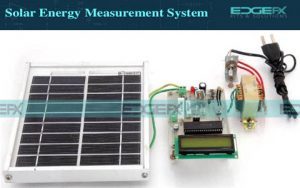
Whether you are assessed a site’s potential for solar power generation, monitoring act of accessible solar installations, or superior solar monitoring, consistent and precise measurements are crucial. They help in decision making, development of the product, maintenance of the system and in many other ways. General meteorological measurements with wind direction, wind speed, relative humidity, barometric pressure and rainfall, all have they’re applied in solar applications. Of course, the solar energy measurements are particularly significant and sensors are accessible for measuring all features of solar radiation.
Solar energy measurement using Pic Microcontroller:
The main purpose of this solar energy measurement system project is to design a solar energy measurement system for determining the solar cell parameters like current, voltage, temperature and also light intensity through multiple sensors.
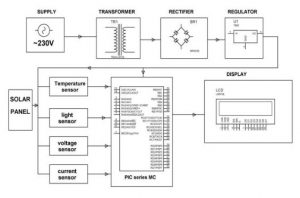
Solar Energy Measurement System Block Diagram
The hardware requirements of this project include the following
- Transformer (230 – 12 v ac)
- Voltage regulator (lM 7805)
- Rectifier
- Filter
- PIC microcontroller (16f877a)
- LED
- Push buttons
- Solar panel
- LDR
- LCD
- 1N4007
- Resistor
- Capacitor
Power Supply:
The power supply consists of a 230/12V step-down transformer, which steps down the voltage to 12V AC. This is transformed to DC with the help of a bridge rectifier. The ripples are removed using a capacitive filter and it is then regulated to +5V using a voltage regulator 7805 which is necessary for the microcontroller operation and other circuits.
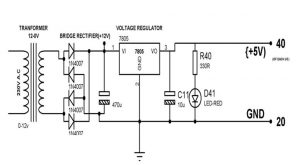
Power Supply
PIC (PIC16F877A):
- High-Performance RISC CPU
- Only 35 single-word instructions.
- All single-cycle instructions except for program branches, which are two cycles.
- Operating speed: DC – 20 MHz clock input DC – 200 ns instruction cycle
- Up to 8K x 14 words of Flash Program Memory, Up to 368 x 8 bytes of Data Memory (RAM),
- Up to 256 x 8 bytes of EEPROM Data Memory.
- Pinout compatible with other 28-pin or 40/44-pin, PIC16CXXX and PIC16FXXX microcontrollers.
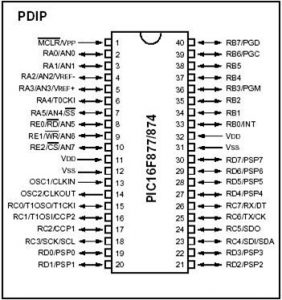
Special Microcontroller Features
- 100,000 erase/write cycle Enhanced Flash program memory typical.
- 1,000,000 erase/write cycle Data EEPROM memory typical.
- Data EEPROM Retention > 40 years.
- Self-reprogrammable under software control.
- In-Circuit Serial Programming™ (ICSP™) via two pins.
- Single-supply 5V In-Circuit Serial Programming.
- Watchdog Timer (WDT) with its own on-chip RC oscillator for reliable operation.
- Programmable code protection.
- Power saving Sleep mode.
- Selectable oscillator options.
- In-Circuit Debug (ICD) via two pins.
LEDs
LEDs are semiconductor devices are made out of silicon, When current passes through the LED, it emits photons as a byproduct. Normal light bulbs produce light by heating a metal filament until its white hot.
LEDs present many advantages over traditional light sources including lower energy consumption, longer lifetime, improved robustness, smaller size and faster switching.
Solar Panel
Expose the cell to light, and the energy from each photon (light particle) hitting the silicon, will liberate an electron and a corresponding hole. If this happens within range of the electric field’s influence, the electrons will be sent to the N side and the holes to the P-one, resulting in yet further disruption of electrical neutrality.This flow of electrons is current; the electrical field in the cell causes a voltage and the product of these two is power.

Photovoltaic Cells
Photovoltaic (PV) cells are made of special materials called semiconductors such as silicon, which is currently the most commonly used. Basically, when light strikes the cell, a certain portion of it is absorbed by the semiconductor material.
PV cells also all have one or more electric fields that act to force electrons freed by light absorption to flow in a certain direction. This flow of electrons is current, and by placing metal contacts on the top and bottom of the PV cell, we can draw that current off to use externally.
Temperature Sensor(LM35)
The LM35 series are precision integrated-circuit temperature sensors, whose output voltage is linearly proportional to the Celsius (Centigrade) temperature. The LM35 thus has an advantage over linear temperature sensors calibrated in Kelvin, as the user is not required to subtract a large constant voltage from its output to obtain convenient Centigrade scaling.
The LM35 does not require any external calibration or trimming to provide typical accuracies of ±1⁄4˚C at room temperature and ±3⁄4˚C over a full −55 to +150˚C temperature range.
LDR
A photoresistor or light dependent resistor (LDR) is a resistor whose resistance decreases with increasing incident light intensity.It can also be referred to as a photoconductor. A photoresistor is made of a high resistance semiconductor.

If light falling on the device is of high enough frequency, photons absorbed by the semiconductor give bound electrons enough energy to jump into the conduction band.
Liquid Crystal Display (LCD)
Most common LCDs connected to the microcontrollers are 16×2 and 20×2 displays. This means 16 characters per line by 2 lines and 20 characters per line by 2 lines, respectively. The standard is referred to as HD44780U, which refers to the controller chip which receives data from an external source (and communicates directly with the LCD.
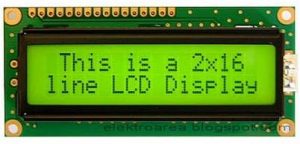
LCD Background
- If an 8-bit data bus is used the LCD will require 11 data lines (3 control lines plus the 8 lines for the data bus).
- The three control lines are referred to as EN, RS, and RW EN=Enable (used to tell the LCD that you are sending it data)
- RS=Register Select (When RS is low (0), data is treated as a command) (When RS is High(1), data being sent is text data )
- R/W=Read/Write (When RW is low (0), the data written to the LCD) (When RW is low (0), the data reading to the LCD).

Project Description
The aim of this solar energy measurement system project is to calculate solar cell factors through numerous sensor data acquisition. In this proposed system, a solar panel is employed to keep monitoring the sunlight. Here different factors of the solar panel namely the intensity of light, current, voltage, and the temperature are monitored.
The microcontroller used here is PIC16F8 family. The LDR sensor is used to monitor the light intensity, voltage by voltage divider rule, current by the current sensor, and temperature by the temperature sensor. All these information are exhibited on a 16X2 LCD interfaced to PIC microcontroller.
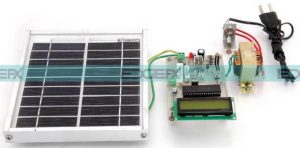
From the above information finally, we can conclude that by using this project we can measure parameters of solar panel using PIC16F877A microcontroller. An LCD display is used to display values of these parameters. We hope that you have got a better understanding of this concept. Furthermore, any queries in implementing the projects please give your feedback by commenting on the comment section below. Here is a question for you, what are the applications of solar energy measurement system?
Read More: Click here to Visit source site
